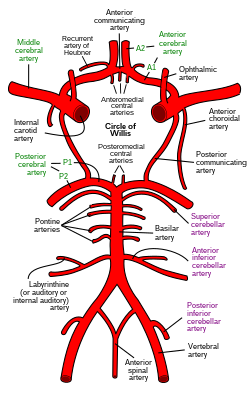Raymond–Céstan syndrome
Editor-In-Chief: Prab R Tumpati, MD
Obesity, Sleep & Internal medicine
Founder, WikiMD Wellnesspedia &
W8MD medical weight loss NYC and sleep center NYC
| Raymond–Céstan syndrome | |
|---|---|

| |
| Synonyms | |
| Pronounce | |
| Specialty | Neurology |
| Symptoms | Contralateral hemiparesis, ipsilateral cerebellar ataxia, dysarthria, nystagmus, diplopia |
| Complications | |
| Onset | |
| Duration | |
| Types | |
| Causes | Occlusion of the basilar artery or its branches |
| Risks | |
| Diagnosis | Clinical diagnosis, neuroimaging |
| Differential diagnosis | Other brainstem syndromes |
| Prevention | |
| Treatment | Supportive care, rehabilitation |
| Medication | |
| Prognosis | |
| Frequency | Rare |
| Deaths | |
Raymond–Céstan syndrome is a rare neurological disorder characterized by a variety of symptoms resulting from damage to the cerebellum. The syndrome is named after the French neurologists, Joseph Jules Dejerine and Jean Alexandre Barré, who first described the condition in the late 19th and early 20th centuries.
Symptoms
The symptoms of Raymond–Céstan syndrome can vary widely, but often include ataxia (a lack of muscle control during voluntary movements), dysarthria (difficulty speaking), nystagmus (involuntary eye movement), and hypotonia (reduced muscle tone). Some patients may also experience dysphagia (difficulty swallowing), vertigo (a sensation of spinning), and tremor.
Causes
Raymond–Céstan syndrome is caused by damage to the cerebellum, a part of the brain that plays an important role in motor control. This damage can be caused by a variety of factors, including stroke, tumor, trauma, or infection. In some cases, the cause of the damage may be unknown.
Diagnosis
Diagnosis of Raymond–Céstan syndrome is based on a combination of clinical symptoms and imaging studies, such as MRI or CT scan. These imaging studies can reveal damage to the cerebellum. In some cases, a neurological examination may also be performed to assess the patient's motor function and coordination.
Treatment
Treatment for Raymond–Céstan syndrome is primarily supportive and aimed at managing symptoms. This may include physical therapy to improve motor function, speech therapy to address dysarthria, and medication to manage symptoms such as vertigo and tremor. In some cases, surgery may be required to remove a tumor or alleviate pressure on the cerebellum.
Prognosis
The prognosis for Raymond–Céstan syndrome can vary widely depending on the underlying cause of the cerebellar damage. Some patients may experience significant improvement with treatment, while others may have persistent symptoms.
See also
Transform your life with W8MD's budget GLP-1 injections from $125.
W8MD offers a medical weight loss program to lose weight in Philadelphia. Our physician-supervised medical weight loss provides:
- Most insurances accepted or discounted self-pay rates. We will obtain insurance prior authorizations if needed.
- Generic GLP1 weight loss injections from $125 for the starting dose.
- Also offer prescription weight loss medications including Phentermine, Qsymia, Diethylpropion, Contrave etc.
NYC weight loss doctor appointments
Start your NYC weight loss journey today at our NYC medical weight loss and Philadelphia medical weight loss clinics.
- Call 718-946-5500 to lose weight in NYC or for medical weight loss in Philadelphia 215-676-2334.
- Tags:NYC medical weight loss, Philadelphia lose weight Zepbound NYC, Budget GLP1 weight loss injections, Wegovy Philadelphia, Wegovy NYC, Philadelphia medical weight loss, Brookly weight loss and Wegovy NYC
|
WikiMD's Wellness Encyclopedia |
| Let Food Be Thy Medicine Medicine Thy Food - Hippocrates |
Medical Disclaimer: WikiMD is not a substitute for professional medical advice. The information on WikiMD is provided as an information resource only, may be incorrect, outdated or misleading, and is not to be used or relied on for any diagnostic or treatment purposes. Please consult your health care provider before making any healthcare decisions or for guidance about a specific medical condition. WikiMD expressly disclaims responsibility, and shall have no liability, for any damages, loss, injury, or liability whatsoever suffered as a result of your reliance on the information contained in this site. By visiting this site you agree to the foregoing terms and conditions, which may from time to time be changed or supplemented by WikiMD. If you do not agree to the foregoing terms and conditions, you should not enter or use this site. See full disclaimer.
Credits:Most images are courtesy of Wikimedia commons, and templates, categories Wikipedia, licensed under CC BY SA or similar.
Translate this page: - East Asian
中文,
日本,
한국어,
South Asian
हिन्दी,
தமிழ்,
తెలుగు,
Urdu,
ಕನ್ನಡ,
Southeast Asian
Indonesian,
Vietnamese,
Thai,
မြန်မာဘာသာ,
বাংলা
European
español,
Deutsch,
français,
Greek,
português do Brasil,
polski,
română,
русский,
Nederlands,
norsk,
svenska,
suomi,
Italian
Middle Eastern & African
عربى,
Turkish,
Persian,
Hebrew,
Afrikaans,
isiZulu,
Kiswahili,
Other
Bulgarian,
Hungarian,
Czech,
Swedish,
മലയാളം,
मराठी,
ਪੰਜਾਬੀ,
ગુજરાતી,
Portuguese,
Ukrainian
Contributors: Prab R. Tumpati, MD

